Species Human Entrez 6514 | Human Mouse Ensembl ENSG00000163581 | |
 | ||
Aliases SLC2A2, GLUT2, solute carrier family 2 member 2 External IDs MGI: 1095438 HomoloGene: 68047 GeneCards: SLC2A2 | ||
Glucose transporter 2 (GLUT2) also known as solute carrier family 2 (facilitated glucose transporter), member 2 (SLC2A2) is a transmembrane carrier protein that enables protein facilitated glucose movement across cell membranes. It is the principal transporter for transfer of glucose between liver and blood, and has a role in renal glucose reabsorption. It is also capable of transporting fructose. Unlike GLUT4, it does not rely on insulin for facilitated diffusion.
Contents
In humans, this protein is encoded by the SLC2A2 gene.
Tissue distribution
GLUT2 is found in cellular membranes of:
Function
GLUT2 has high capacity for glucose but low affinity (high Km, ca. 15-20 mM) and thus functions as part of the "glucose sensor" in pancreatic β-cells. It is a very efficient carrier for glucose.
GLUT2 also carries glucosamine.
When the glucose concentration in the lumen of the small intestine goes above 30mM, such as occurs in the fed-state, GLUT2 is up-regulated at the brush border membrane, enhancing the capacity of glucose transport. Basolateral GLUT2 in enterocytes also aids in the transport of fructose into the bloodstream through glucose-dependent cotransport.
Clinical significance
Defects in the SLC2A2 gene are associated with a particular type of glycogen storage disease called Fanconi-Bickel syndrome.
In drug-treated diabetic pregnancies in which glucose levels in the woman are uncontrolled, neural tube and cardiac defects in the early-developing brain, spine, and heart depend upon functional GLUT2 carriers, and defects in the GLUT2 gene have been shown to be protective against such defects in rats. However, whilst a lack of GLUT2 adaptability is negative, it is important to remember the fact that the main result of untreated gestational diabetes appears to cause babies to be of above-average size, which may well be an advantage that is managed very well with a healthy GLUT2 status.
Maintaining a regulated osmotic balance of sugar concentration between the blood circulation and the interstitial spaces is critical in some cases of edema including cerebral edema.
GLUT2 appears to be particularly important to osmoregulation, and preventing edema-induced stroke, transient ischemic attack or coma, especially when blood glucose concentration is above average. GLUT2 could reasonably be referred to as the "diabetic glucose transporter" or a "stress hyperglycemia glucose transporter."
Interactive pathway map
Click on genes, proteins and metabolites below to link to respective articles.
